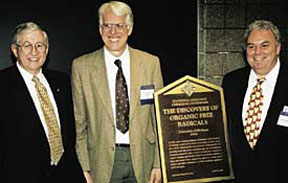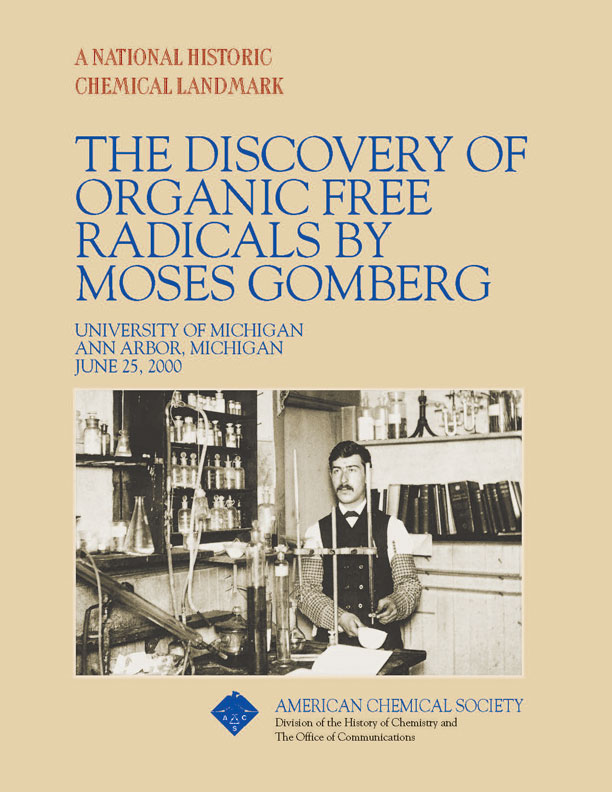Moses Gomberg and the Discovery of Organic Free Radicals
Dedicated June 25, 2000, at the University of Michigan in Ann Arbor, Michigan.
Moses Gomberg, a chemistry professor at the University of Michigan, discovered an organic free radical in 1900 and affirmed what had been thought impossible. A century later, free radical organic chemistry researchers look back to Gomberg as the founder of their field. His work led to modern theories of the structure and reactivity of organic molecule—theories whose application has had tremendous impact on modern life.
Contents
The Discovery of Organic Free Radicals
Nineteenth century scientists speculated that there could be a free radical containing carbon — an organic free radical. But after many attempts to isolate it failed, they concluded they were wrong and that carbon must always be tetravalent (form four bonds).
Moses Gomberg was trying to synthesize a carbon compound called hexaphenylethane when he inadvertently synthesized triphenylmethyl (trityl for short), a mysterious, highly reactive, unstable substance. He recognized that he had found the long-elusive free radical and showed that carbon is not always tetravalent — the then prevailing view.
Gomberg published his findings in 1900, but the existence of triphenylmethyl and other organic free radicals remained in dispute for nearly a decade. They were viewed as a curiosity even after the scientific community recognized their existence. Not until the 1930s did free radicals enter the mainstream of organic chemistry.
We now know that organic free radicals are essential to the way in which some enzymes function in the human body. We know that organic free radicals are involved in the body's aging process, in its healthy functioning, and in the development of cancer and other serious diseases. Understanding organic free radicals has helped us explain DNA synthesis in the body and many other natural phenomena, from food spoilage to the effects of sunburn. Organic free radicals also play a major role in the production of plastics, synthetic rubber and other widely used synthetic materials.
What are Organic Free Radicals?
Atoms form molecules by sharing electrons, and electrons pair up with one another. Each pair of electrons constitutes a chemical bond. Most molecules contain an even number of electrons.
A free radical is an atom or a group of atoms with an odd number of electrons. The odd, unpaired electron in a free radical seeks to pair (form a bond) with another electron. Most free radicals are so reactive they exist only for a fleeting moment.
Organic molecules contain carbon, which very readily forms four electron pairs (bonds) when reacting with other atoms or molecules. An organic free radical is a free radical form of carbon with three bonds and a single, unpaired electron.
A free radical can react with another free radical, but more often it reacts with a stable, evenly paired molecule. It does so by (1) donating an electron to the molecule, (2) removing an electron from the molecule, (3) removing a group of atoms from the molecule, or (4) adding itself to the molecule. When a free radical reacts with a stable molecule in these ways, it turns the stable molecule into a free radical. This can set in motion a chain reaction of free radical formation.
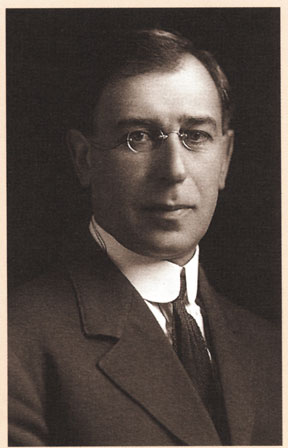
Moses Gomberg’s Discovery of Triphenylmethyl and Free Radicals
Moses Gomberg studied analytical chemistry at the University of Michigan and synthetic chemistry in Germany, then the world’s main center of chemical research. That combination of experience equipped him to recognize his historic discovery for what it was.
At Adolf Baeyer’s laboratory at the University of Munich, Gomberg worked closely with Johannes Thiele, whose partial valence theory explained organic compound reactivity by assigning partial bonds to carbons in chains with alternating single and double bonds. Earlier, Baeyer had succeeded in synthesizing organic compounds with August Kekulé, but not tetraphenylmethane. Several prominent chemists, among them Victor Meyer, had also failed in their attempts to synthesize tetraphenylmethane. They concluded it was inherently unstable.
At the University of Heidelberg, where he worked with Meyer, Gomberg took a different approach based on Thiele’s work. He succeeded where others had failed and obtained a tiny amount of tetraphenylmethane.
Gomberg returned to Michigan, where he improved the yield slightly. He then tried to produce the next fully phenylated hydrocarbon — hexapheynlethane — by reacting triphenylmethyl halides with sodium in benzene. When this failed, he repeated the experiment using silver instead of sodium. He obtained a white crystalline powder that reacted with oxygen in the air.
To avoid this oxidation, Gomberg reacted triphenylmethyl chloride and zinc in an atmosphere of carbon dioxide. Sometimes, he allowed the experiment to run for weeks in a special airtight apparatus he had constructed. The reaction produced a thick, dark yellow syrup.
Gomberg removed the benzene solvent at reduced pressure, leaving behind a white solid of unexpectedly high reactivity. It oxidized rapidly in the air and reacted readily with halogens, including iodine. These properties were not what Gomberg expected from hexaphenylethane. “The experimental evidence…forces me to the conclusion that we have to deal here with a free radical, triphenylmethyl,” he wrote in his published findings. “On this assumption alone do the results described above become intelligible and receive an adequate explanation… The radical so formed is apparently stable, for it can be kept both in solution and in the dry crystalline state for weeks.”
Gomberg published his findings in 1900 in the Journal of the American Chemical Society and in Germany’s Berichte der Deutschen Chemischen Gesellschaft. Publishing simultaneously in English and German was a common practice at the time among U.S. scientists with links to Germany. It was also common to designate oneself the proprieter of a new field, as Gomberg did in the conclusion of his paper: “This work will be continued and I wish to reserve the field for myself.”
Other chemists greeted Gomberg’s discovery with skepticism. Most remained convinced that carbon must be tetravalent—understandable given that the explanation, electronic bonding, would not be articulated until years later by scientists such as G.N. Lewis, Walter Kossel and Irving Langmuir.
Free Radicals: A Wide-reaching Legacy
The scientific community began recognizing the importance of free radicals in 1929, when Friedrich Paneth and Wilhelm Hofeditz produced the methyl free radical, CH3. Unlike the trityl radical, the methyl radical was elusive and could not be isolated. This showed that organic free radicals can exist momentarily and suggested that many chemical reactions involve free radicals.
In 1933, Morris Kharasch and his student, Frank Mayo, invoked a free-radical mechanism and discovered "the peroxide effect," which they subsequently applied to other chemical systems. Their work, coupled with that of Gomberg and others, paved the way to development of synthetic materials ranging from rubber to plastics.
Conventional polymerization continued to be used to produce nylon and other products. But free radical polymerization had advantages such as high tolerance of chemical impurities and extreme temperatures, and the ability to be used with a wide range of monomers (organic molecules). Today, free radicals are used to produce nearly half the polymers we use — materials used in everything from food wrapping to paint, adhesives, film, carpeting, piping, and more.
In medicine, understanding free radicals, particularly those formed by oxygen, has illuminated the nature of oxidative stress — damage that results when free radicals form faster than the body removes them. This, in turn, has revealed ways human health can be improved — for example, by using antioxidants. We now recognize that many free radicals are essential components of enzymes in the body, while others can damage DNA, leading to cancer or other diseases. We know, for example, that free radicals formed by excessive exposure to the sun's ultraviolet light can lead to cataracts.
Many free radical processes involve chain reactions that begin when an unpaired electron fails to find another unpaired electron with which it can easily bond. The free radical removes an atom (usually hydrogen) from another molecule, turning itself into a stable molecule; the molecule it attacked becomes a free radical. Such chain reactions are used to make environmentally friendly products such as recyclable automobile tires and soaps free of salts.
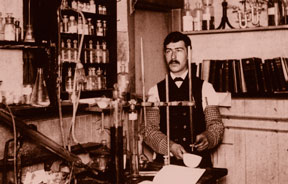
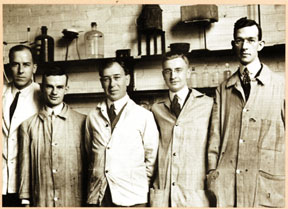
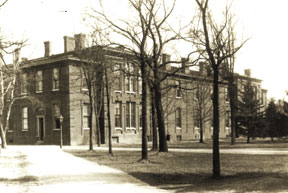
Biography of Moses Gomberg (1866-1947)
Moses Gomberg was born on February 8, 1866, in Elizavetgrad, Russia, (now known as Kirovograd, Ukraine) a town south of Kiev. Because the family was Jewish, it received harsh treatment after the assassination of Tsar Alexander II in 1881. The government accused Gomberg's father of anti-tsarist activities and confiscated the family farm in 1884. The 18-year-old Gomberg also fell under suspicion.
The family fled to the United States, settling in Chicago, Illinois. There, young Moses followed the classic immigrant path to success. Speaking no English, he worked at odd jobs, most involving menial labor. He toiled in the Chicago stockyards under the brutal conditions described in Upton Sinclair's novel, The Jungle.
Through sheer force of will and brainpower, Gomberg learned English, completed his secondary education, and in 1886 entered the University of Michigan. He tried to enroll in a beginning course in physics, but the department head turned him down because he had no formal training in trigonometry. Three days later, he tried again. When the department again rejected him for the same reason, Gomberg insisted he knew the subject. The department head quizzed him, and was stunned to find that what he claimed was true.
Gomberg earned his Ph.D. in 1894 and remained at Michigan for the rest of his professional life, except for a year spent in Germany and a summer at the University of California. Widely regarded as a fine teacher and lecturer, he was appointed an assistant professor in 1899 and a full professor in 1904; he chaired Michigan's chemistry department from 1927 until he retired in 1936.
Gomberg lived quietly, sharing a house in Ann Arbor with his sister, Sonia. Her health began to fail around the time of his retirement, and he spent most of the rest of his life caring for her. He died on February 12, 1947, four days after his 81st birthday.
Those who knew Gomberg remembered him as kind, generous and modest, as well as a man with strong convictions. He was unfailingly courteous.
Although Gomberg is best known for his discovery of organic free radicals, he made many other contributions to organic and applied chemistry. He developed new solvents for automobile lacquers, the first antifreeze compound used in cars, and a procedure for producing mustard gas during World War I.
He received honorary degrees from the University of Chicago, Brooklyn Polytechnic Institute, and the University of Michigan, as well as three medals from the American Chemical Society: the Nichols Medal in 1914, the Willard Gibbs Medal in 1925, and the Chandler Medal in 1927. He was elected to the National Academy of Sciences in 1914, and served as president of the American Chemical Society in 1931.
Further Reading
- Moses Gomberg (University of Michigan Faculty History Project)
- Moses Gomberg, 1866-1947 (National Academy of Sciences)
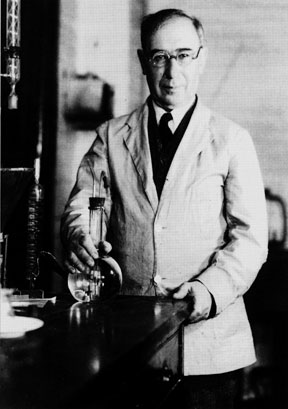
Landmark Designation and Acknowledgments
Landmark Designation
The American Chemical Society designated the discovery of organic free radicals by Moses Gomberg as a National Historic Chemical Landmark in a ceremony at the University of Michigan in Ann Arbor, Michigan, on June 25, 2000, during the 100th anniversary of the discovery. The plaque commemorating the event reads:
In 1900, Moses Gomberg, Professor of Chemistry at the University of Michigan, confirmed the existence of a stable, trivalent organic free radical: triphenylmethyl. In so doing, he challenged the then prevailing belief that carbon could have only four chemical bonds. Gomberg’s discovery made a major contribution to theoretical organic chemistry and fostered a field of research that continues to grow and expand. Today, organic free radicals are widely used in plastics and rubber manufacture, as well as medicine, agriculture and biochemistry.
Acknowledgments
Adapted for the internet from “The Discovery of Organic Free Radicals by Moses Gomberg,” produced by the National Historic Chemical Landmarks program of the American Chemical Society in 2000.
Learn more: About the Landmarks Program
Take action: Nominate a Landmark and Contact the NHCL Coordinator
